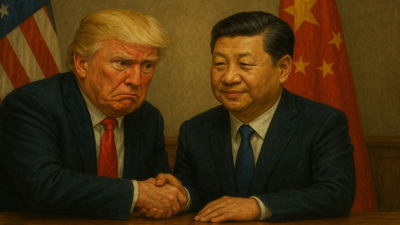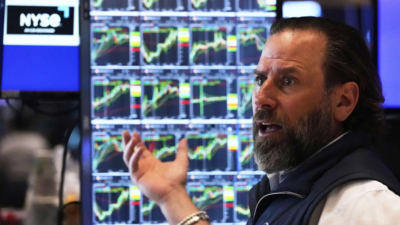Trump’s tariff tumble: The twist in US-China trade war

By all appearances, Donald Trump is looking for a way out. Just months into his second presidency, the US President is signaling a retreat – or at least a recalibration – on one of his most aggressive economic fronts: the trade war with China.
At a White House press conference on Tuesday, Trump appeared to temper his earlier hardline stance on tariffs, saying duties on Chinese imports “will come down substantially” but “won’t be zero.” His tone was markedly less confrontational: “We’re going to be very nice and they’re going to be very nice,” he said, striking an oddly conciliatory note for a man who just weeks ago called Chinese trade practices “cheating at a planetary scale.”
To some, this sounded like strategy. But to many experts and investors, it sounded more like anxiety.
“Trump is panicking due to the markets plummeting and still very high US treasury yields,” said Alicia Garcia-Herrero, chief economist for Asia-Pacific at Natixis, in comments to the South China Morning Post. “He needs a deal – and quick. China does not need to offer anything big in such circumstances.”
Beijing isn’t biting
- For now, Beijing appears in no rush to respond. And that, experts say, is precisely the point.
- Chinese President
Xi Jinping has maintained radio silence even as Trump continues to dangle public invitations for dialogue. The response from Beijing has been calculated – and increasingly cold. - According to the Kobeissi Letter, state-backed Chinese funds have begun pulling back from US private equity investments under pressure from the government. Major players like the China Investment Corporation have halted planned commitments, and Chinese investors are avoiding US-linked deals, even when managed offshore.
- The message: China is not only refusing to blink — it’s preparing to go without.
- This week, China’s commerce ministry issued a blunt warning: it “firmly opposes any party reaching a deal at the expense of China’s interests.” It’s a posture steeped in nationalism and, increasingly, leverage.
‘We have an embargo now’
Despite the White House’s optimistic language, the broader reality is grim. Treasury secretary Scott Bessent privately admitted in a closed-door investor summit that the current status quo – 145% tariffs by the US and 125% retaliatory duties from China — amounts to “a two-way embargo.” Though he predicted “de-escalation” in the near future, he conceded that formal negotiations haven’t even begun.
“No one thinks the current situation is sustainable,” Bessent said. But he also acknowledged the absence of a road map.
Markets responded favorably – temporarily. The S&P 500 rose 2.5% on the day, buoyed by hopes that Washington might finally relent. But the deeper concern is structural: the tariffs have roiled financial markets, triggered selloffs in US Treasuries, and spooked investors who once viewed the dollar as a safe haven.
As the New York Times noted, Trump’s personalized approach – ratcheting up pressure to force a top-level summit – has so far failed. Xi Jinping, it seems, won’t be strong-armed into a phone call, the NYT said.
‘The more he talks, the more anxious he looks’
Trump’s own remarks may be undercutting his leverage. “In reality, there hasn’t been any substantial progress or change in the US-China tariff negotiations,” said Chen Zhiwu, a professor of finance at the University of Hong Kong. “This is [Trump’s] way of signaling to China.”
“But the more he talks like this, the more it shows how anxious the US side is,” Chen told the SCMP. “Trump and his team are under pressure, but China isn’t showing any signs of impatience.”
Others agree that Trump’s apparent softening is likely a reflection of pressure at home — not progress abroad.
“Rising living costs, economic disarray, and popular discontent will eventually force a definite pivot,” said Xu Tianchen of the Economist Intelligence Unit. For now, he said, Trump’s tariff comments appear more like improvisation than strategy. “Things are still pretty fluid.”
A self-inflicted wound?
- If Trump’s goal was to pressure Beijing into concessions, analysts argue he may have misjudged the moment – and his opponent.
- The 145% tariffs have hurt Chinese exporters, but they’ve also fueled inflation in the US, raised costs for American businesses, and alienated allies. China, by contrast, appears increasingly insulated. Years of preparation — diversifying trade routes, investing in domestic supply chains, and cultivating new markets in Asia, Africa, and Europe — have paid off.
- Beijing has been methodical, and perhaps more importantly, patient.
- US-China relations are in “effectively a state of economic war,” Susan Thornton, who served as acting top US diplomat for East Asia during Trump’s first administration, told AFP.
- “China views Trump’s stated intent to… erect a ‘tariff wall against China’ as illegal and an existential threat,” Thornton, now a senior fellow at Yale’s Paul Tsai China Center, said.
- Meanwhile, Washington is bleeding goodwill – and time.
No deal, no summit
Even the possibility of a Trump-Xi summit now seems remote. “Trump has torched any realistic chance of a near-term meeting,” said Wu Xinbo of Fudan University. “His behavior is seen as rude and unreasonable — there’s no trust.”
Others echo that view. “Neither Trump nor Xi will want to convey that he has yielded to the other,” Ali Wyne of the International Crisis Group told AFP. “They both want to look strong. But Xi has the advantage of time.”
For Beijing, a deal now – under economic duress and political chaos in Washington – would look like capitulation. That is politically untenable for Xi, who has spent years cultivating an image of strength and resolve.
(With inputs from agencies)




